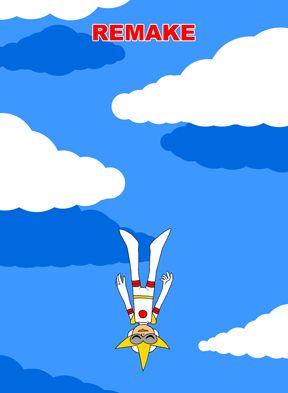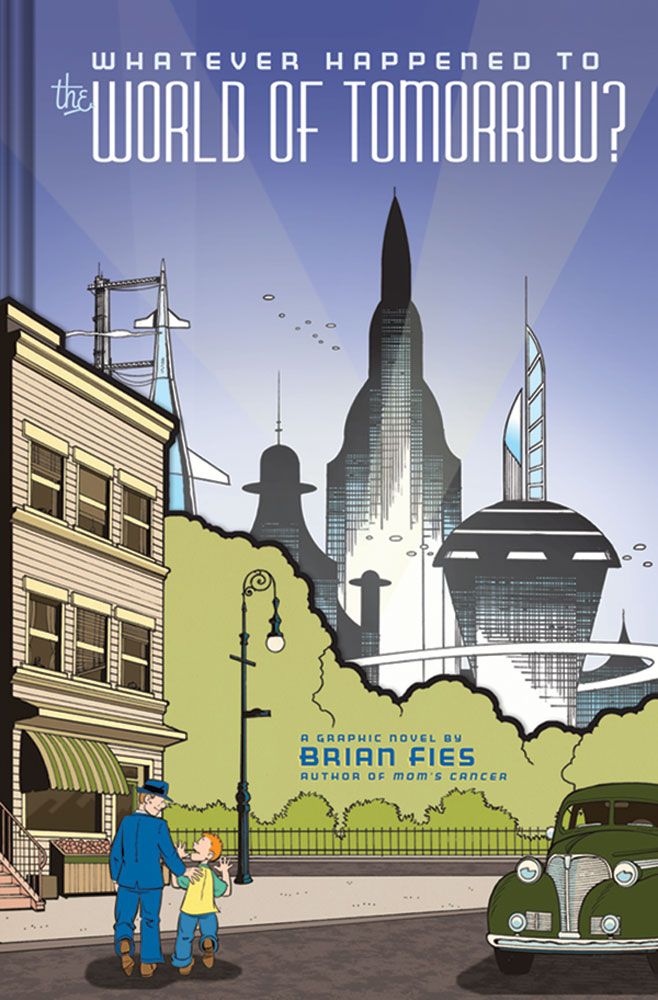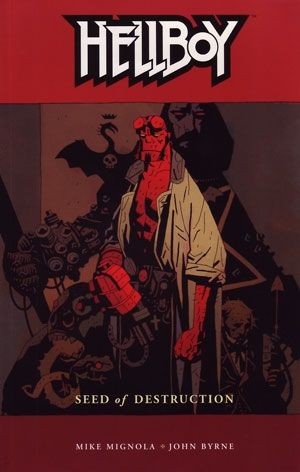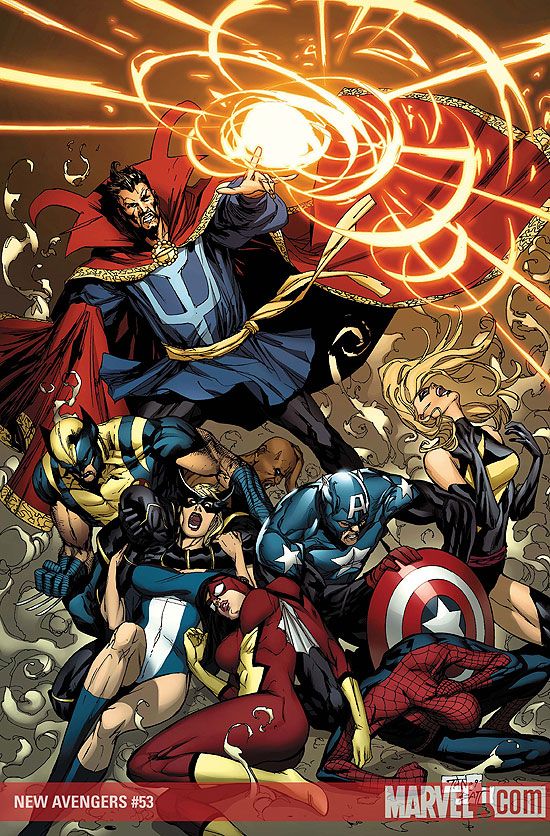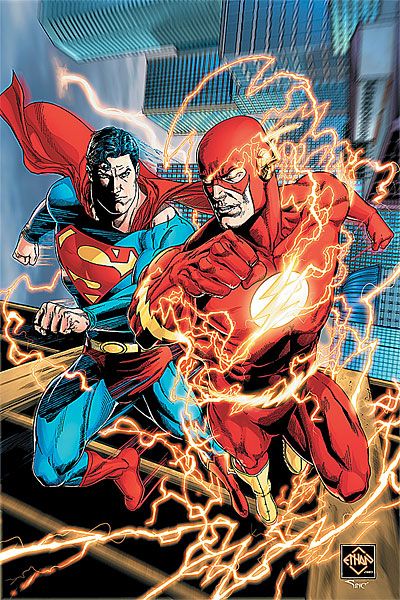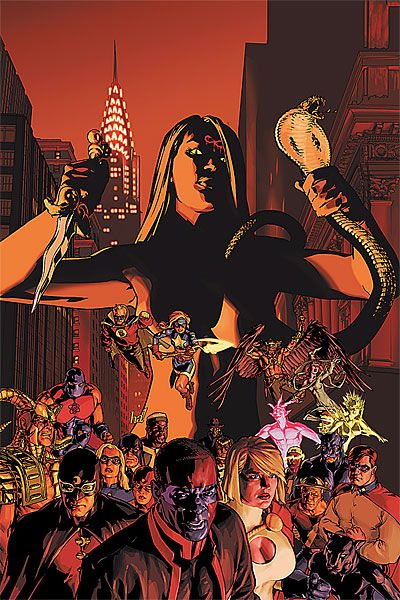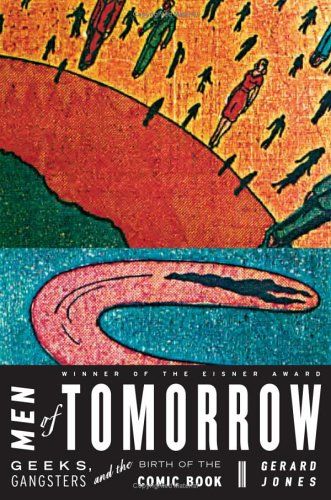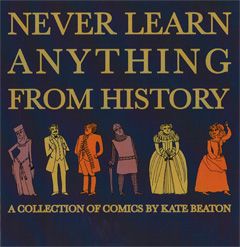The weeks go by so quickly now. Welcome once again to What Are You Reading. Our special guest this week is fellow CBR contributor, former Wizard staffer and interview expert Kiel Phegley. Kiel just got back from MoCCA with a passel of books and he's eager to talk about them, as is the rest of the Robot 6 crew. Don't forget, though, to let us know what you're currently reading in the comments below.
Brigid Alverson: The standout book for me this week is Brian Fies’ Whatever Happened to the World of Tomorrow. The first thing that struck me was the amount of care that was put into this book—not just the high production quality, but the extra touches like a die-cut cover band and the faux-pulp paper used for the faux-retro comic. The topic is American optimism and our vision of the future, and he takes it in slices — a visit to the New York World’s Fair in 1939, the end of World War II, the 1950s — as viewed by a boy and his father, who age so slowly that they are young in every era the story touches. This narrative is interspersed with episodes of a beautifully faked science-fiction comic (complete with ads, copyright notice, and bad color registration) that presents the themes in a different way. My one complaint would be that it’s bit didactic — we are presented with many earnest chunks of text about history and scientific progress — but in a way, that’s another reflection of the core concept — the text reads like a lot of popular literature and TV scripts from those eras.
From the future to the past: The History of the West Wing, by Sun Jiayu and Guo Guo, is a Chinese graphic novel based on a classic play that in turn was modeled on a ninth-century fable. It’s a love story between a princess and a slacker, and it’s not very deep, but the art is lovely. Everyone is willowy and pale and kitted out in elaborately patterned robes and super-elaborate hairstyles, and the story is broken up with splash pages that might as well have “suitable for framing” printed on them: A girl on a swing, the lovers in a pensive moment, etc. Neither the characters nor the story have much depth, but the book ends before you have a chance to get bored.
I have been trolling the web looking for webcomics to write about for the Unbound column, and this one caught my eye after it was recommended by Gary Tyrrell of Fleen: Digger, by Ursula Vernon. I have just started reading it but it’s really pulling me in. The main character is a wombat who is digging tunnels and winds up in a temple, talking to a statue of the god Ganesh. Yes, it’s a weird concept, but it makes sense in context. This is trickier than it seems. A comic may be fiction or fantasy, but it still has to be plausible within the created world. Many, many comics (and books) fail at this. Digger works. Of course, I’m only 15 pages into it, but I certainly hope it lives up to its early promise.
Michael May: I've finally started to re-read the Hellboy collections. I stopped buying the single issues a while ago and have gotten behind on the story, so I'm looking forward to catching up. Started with Seed of Destruction of course. It's been a while since I'd read it (or any Mignola-drawn Hellboy, for that matter), so the art really stunned me all over again. I've gotten used to seeing other people draw the characters, but as talented as those folks are (I mean, there's no way I'm going to complain about Guy Davis art), Mignola's stuff is so powerful. So unsettling in the best possible way.
It's always jarring reading John Byrne's text over Seed of Destruction, but I see that more as a curiosity of this first collection than a weakness or even a distraction. If Mignola had never decided to write the comics himself and Byrne had continued doing it, I still would've loved it, not knowing what I was missing. But wow am I thankful Mignola chose to take on that task too. Hellboy is best when the images are doing the heaviest work. I'm not usually a stop-and-soak-in-the-art kind of comics reader, but I am when it's Hellboy. Lots of text and caption boxes get in my way and Mignola's visual storytelling is so amazing that he doesn't need that stuff anyway.
John Parkin: I second Brigid's recommendation of Digger, which I found through Fleen as well.
New Avengers #53 featured one of my faves, Damion Hellstrom, going at it with a severely amped up Hood, as the Avengers finally find out who the new sorcerer supreme is gonna be. But I think the only way this new sorcerer supreme is going to work is if the next issue features surprise guest art by Fred Hembeck.
Cursed Pirate Girl is an odd, fun little title from Jeremy Bastian. And really, it smells like a good comic. If you don't believe me, take a whiff at your local comic shop the next time you're in there.
New Mutants #1 and #2 -- I picked these up this week because curiosity got the better of me. I was a big fan of the original run, esp. those early issues with the Demon Bear and the intro of Warlock, and I figured this title probably couldn't hold up to the nostalgia factor. But this title actually works pretty well. Cannonball, Sunspot, Magma and Magik head to a small Colorado town to find Karma and Mirage, who disappeared during a mission, which eventually leads to them discovering that their old enemy Legion is back. Karma ends up trapped inside Legion's head along with another young mutant, which was creepy enough to be one of the better parts of the story so far. I think the only thing that really bugged me was the portrayal of Cannonball, who came across as more of a hothead than he should have. But overall, much better than I expected, and I plan to pick up the next issue.
And finally, the best thing I read this week was Goon: Chinatown, the hardcover graphic novel that details some of the Goon's past. A great Goon story in a very nice package.
Tim O'Shea: On JK's recommendation from earlier this week, I picked up the The Flash: Rebirth 3 -- and for the most part I was pleased. I'm a tad bewildered by the whole "Barry's dad being accused of killing his mom" reveal that this series offers (did that exist before this series? It just does not strike me as a Silver Age talking point). I mean I guess I should be thankful that the revised backstory did not involve Vandal Savage going back in time to kill Barry's mom -- oh wait let's see how this plays out. But the moment of Wally trying to teach Barry a lesson (suggesting Barry use Iris as a "lightning rod" [as Linda is for Wally] to ground him so to speak) was a nice touch that showed Wally will not just be a vanilla prop in whatever future story Barry has as the Flash.
With the new back-up feature of the Blue Beetle in Booster Gold's ongoing monthly, I feel like I'm in the 1970s again -- in a good way. While $3.99 is a high price to pay for a comic, the hit to my wallet is less painful if I get two good stories for one price. In the main Booster Gold story, Jurgens constructs an effective moment where Booster reveals to the new Bats (Dick Grayson) that he had tried to stop the shooting of Barbara Gordon. In all the shifting of the status quo in DC (ask Dwayne McDuffie how fun that can be to write around and/or try to utilize), that Jurgens was able to utilize the this new status quo effectively was appreciated.
I interviewed Fred Chao in March 2008 after the first three issues of Johnny Hiro came out and I liked what he was doing with these relatively normal characters then. Had I known the Night Court homage he had planned for a later story (published in this new TPB collection), I would have hyped this collection upon its release. Chao is a quirky storyteller with a core basic love story to tell with Johnny Hiro. I hope he revisits the character with another collection or graphic novel down the road. Kudos to AdHouse for publishing such a quirky property.
What might I be talking about next week? The copy of The Photographer by Emmanuel Guibert, Didier Lefèvre and Frédéric Lemercier, which I picked up at the library today.
Finally, I'm enthralled by the Iraq War Stories by Nick Bertozzi's students that has already issued five webcomic chapters already. It's even better than what I envisioned when I first talked to him about the project a few weeks back.
Tom Bondurant: I wasn't going to get the JSA vs. Kobra miniseries (written by Eric Trautmann and penciled by Don Kramer), but fond memories of Trautmann's work on Checkmate (alongside Greg Rucka) made it an impulse buy. The book was worth it. I haven't read a Justice Society book since the "Lightning Saga" crossover two years ago, so I can't compare it to Checkmate; but this issue reminds me of what I loved about that series. It picks up on subplots from Rucka and Trautmann's last arc, "Castling," and it also addresses the fate of Sasha Bordeaux, incapacitated during Final Crisis. Essentially, Mr. Terrific is the link between the two organizations, so he gets a lot of panel time; but Trautmann plays him against JSA leader Power Girl pretty effectively. She's not content to let Checkmate handle the matter, and neither is she comfortable with some of Checkmate's methods. Trautmann also gives us a good taste of Kobra's two-steps-ahead plotting. The art is quite good, with Kramer's pencils enhanced greatly both by Michael Babinski's tight inks and Art Lyon's moody, meticulous colors. This team does both "dynamic" and "creepy" very well.
It took the better part of their tenure, but I think I actually liked the latest issue (#567) of Mark Millar and Bryan Hitch's Fantastic Four. It's probably because this particular issue doesn't feature the FF, focusing instead on Doctor Doom in a world where Reed is dead and a reformed Victor has (for all intents and purposes) taken his place. Naturally, the real threat remains the new bad guy -- the Palpatine to Doom's Vader -- who's disappointed in his apprentice's many failures. The issue is stitched together from moments I would describe as "widescreen-cool," and Millar and Hitch excel at those. (Indeed, I haven't warmed to their FF because they seem more concerned with big, "cool" ideas than anything else.) Therefore, this was an enjoyable issue, but we'll see if that carries over into the rest of this arc.
The lead story in Booster Gold #21 (written and penciled by Dan Jurgens) is essentially another plot to erase a Justice Leaguer from history, but this time it's Batman -- any Batman -- which means Booster has to fight Dick Grayson, once and future Caped Crusader. In practical terms, I thought this issue succeeded at using the new Batman in a mainstream DC Universe story. More importantly for this title, though, it was a good way to introduce those crossover-minded new readers to Booster's setup. This means exposition involving Rip Hunter's motivation and Booster's "below-the-radar" heroics, but that's handled fairly efficiently. Jurgens' layouts and choreography keep things moving, too.
Finally, Booster Gold #21 also marks the debut of its new co-feature, "Blue Beetle" by Matthew Sturges and Mike Norton. I keep meaning to catch up with the paperbacks of Jaime's solo title, so I'm more familiar with him through his appearances elsewhere. Fortunately, Sturges and Norton use their eight pages economically, devoting three panels to Jaime's backstory and the rest of the first page to (what I assume is) his main supporting cast. The story itself involves a giant robot, so it's not exactly plot-intensive, but it does have a nice angle and a good sense of humor. Worth the extra buck, I'd say.
Chris Mautner: I'm finally making my way through Men of Tomorrow, Gerard Jones' excellent nonfiction book about the early history of the comic book industry. It's been sitting on my shelf since it first came out on sale in 2004 but for whatever reason I haven't made the time up till now to sit down with it.
I feel silly for waiting so long. It's a fascinating, addictive read, confirming one's worst suspicions about how not-so-secret origins of the medium, namely that it was founded by a bunch of crooks, shysters and borderline thugs who were loveable rogues at best and just plain rogues at worst. It doesn't have very nice things to say about Mort Weisinger.
I'm also finally starting to peruse Saul Steinberg: Illuminations, a companion book to the 2007 exhibit of the illustrator's work at the Smithsonian American Art Museum. I haven't gotten very far (mainly because I started Jones' book) but it's a lovely book, and makes me wish Steinberg was more of an influence on today's generation of cartoonists, both in and out of The New Yorker.
Kiel Phegley: Like damn near every other comics journalist type, I spent the weekend before last in New York attending the annual MoCCA festival, so pretty much everything I've been getting into since then was purchased at the show. But rather than give you a total laundry list, how's about we just cover the books I dove into first after getting home?
Lamar Abrams' Remake has proven as quirky and snarky as I thought it would when I first saw it previewed on this here blog. I'd hoped for a longer story inside, but Abrams' shorter stuff shows a nice range of style within his manga sendup context, so it's all good.
Kate Beaton's Never Learn Anything From History was also a total no-brainer pick up. Just go buy it, already.
Finally, I was one of those people who was completely shocked and completely psyched that Kazimir Strzepek brought copies of The Mourning Star Vol. 2 unannounced as the first one and his issue of Papercutter made me a lifelong fan. There's nowhere to buy the new book online just yet as far as I can tell, but you can get Vol. 1 here.
Aside from those big ticket items, I really want to give a shout out to the students at the Center For Cartoon Studies, who were out in force with mini comics like they used to make 'em. I included a photo of the crew I met in my CBR write up of the show but didn't have all their names with my as I wrote. So let me point y'all in the direction of Sam Carbaugh whose These Things Happen avoided some of the perils of "Young Artist Autobio Comix" admirably, Jen Vaughn whose Menstruation Station is totally not the kind of comic I generally pick up on my own but was glad to have read after she gave it to me (she was SUPER knowledgeable about the school and her classmates' work as well) and Penina Gal ... well, I didn't meet her, but her The Fire Messenger #1 was absolutely gorgeous. A full color, strangely creepy kids fantasy. Highly recommended.
Speaking of creepy kids comics, the other nice surprise I got at MoCCA came in the form of Megan Baehr's Flashlight. I don't think I met a cartoonist at the show who was more excited to be selling their wares, and Baehr's story of two kids exploring a supposedly haunted subway tunnel displayed some really great cartooning and clean, effective storytelling. The relationship between the characters was enforced in every panel, and the print quality was top notch. This is the kind of thing I wasted all that money on my flight and karaoke nights for.
On the traditional comics side of things, two things I've been pouring over lately are a pair of Marvel Tales issues from 1986 which reprint the famous "Harry Osborn on drugs" issues from later in Stan Lee's run on the book and the infamous "Death of Gwen Stacey" saga that I picked up for a dollar. Reading these for the first time after growing up ignoring the McFarlane through Clone Saga Spidey comics that were popular when I was a kid, I can see a bit better what the current crop of Amazing creators are trying to accomplish with the "Brand New Day" serial.
I've also been returning a lot to Manga, Comic Strip Books from Japan – a companion volume to a 1991 London showing of manga curated by Paul Gravett. Seeing as it only reprints a few pages from a handful of disparate volumes, the book is less of a satisfying reading experience and more of an interesting window into how people were thinking about manga before the 6th graders of America discovered it ten years later. I keep telling myself I'm going to blog about each of these books. Maybe I will sometime.
Finally, on my prose stack this week is Jedediah Berry's The Manual of Detection, a dreamlike noir riff that I think would appeal to anyone who's a fan of Paul Auster or Jonathan Lethem. Berry also works with some former teachers of mine – Small Bear Press operators and comics supporters Kelly Link and Gavin Grant – so bonus cool points for him there. And this week, I just started J. D. Salinger's Franny and Zooey which I bought on a whim because I had $7 on a Borders gift card. Some days I think I was the only 17 year old in America who really disliked The Catcher in the Rye when he first read it, but my buddy Brad has been begging me to check out F & Z for years. I'm only 20 pages in, but so far I really like the English major jokes.


